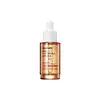What's inside
What's inside
 Key Ingredients
Key Ingredients

 Benefits
Benefits

 Concerns
Concerns

 Ingredients Side-by-side
Ingredients Side-by-side

Water
Skin ConditioningButylene Glycol
HumectantNiacinamide
SmoothingPolyglycerin-3
HumectantMethylpropanediol
Solvent1,2-Hexanediol
Skin ConditioningGlycereth-26
HumectantGlycerin
HumectantMannitol
HumectantSodium Dna
Skin ConditioningPolyglyceryl-10 Laurate
Skin ConditioningMicrocrystalline Cellulose
AbsorbentAmmonium Acryloyldimethyltaurate/Vp Copolymer
Polyacrylate Crosspolymer-6
Emulsion StabilisingAcrylates/C10-30 Alkyl Acrylate Crosspolymer
Emulsion StabilisingArginine
MaskingZea Mays Starch
AbsorbentMilt Extract
Skin ConditioningEthylhexylglycerin
Skin ConditioningMica
Cosmetic ColorantAllantoin
Skin ConditioningCaprylyl Glycol
EmollientAdenosine
Skin ConditioningParfum
MaskingBiosaccharide Gum-1
HumectantCI 77492
Cosmetic ColorantSodium Hyaluronate
HumectantTranexamic Acid
AstringentCalcium Pantothenate
Maltodextrin
AbsorbentSodium Starch Octenylsuccinate
AbsorbentSodium Ascorbyl Phosphate
AntioxidantTocopheryl Acetate
AntioxidantPyridoxine Hcl
Skin ConditioningHydrolyzed Hyaluronic Acid
HumectantHydrolyzed Sodium Dna
Skin ConditioningHyaluronic Acid
HumectantSodium Acetylated Hyaluronate
HumectantTripeptide-1
Skin ConditioningAcetyl Hexapeptide-8
HumectantWater, Butylene Glycol, Niacinamide, Polyglycerin-3, Methylpropanediol, 1,2-Hexanediol, Glycereth-26, Glycerin, Mannitol, Sodium Dna, Polyglyceryl-10 Laurate, Microcrystalline Cellulose, Ammonium Acryloyldimethyltaurate/Vp Copolymer, Polyacrylate Crosspolymer-6, Acrylates/C10-30 Alkyl Acrylate Crosspolymer, Arginine, Zea Mays Starch, Milt Extract, Ethylhexylglycerin, Mica, Allantoin, Caprylyl Glycol, Adenosine, Parfum, Biosaccharide Gum-1, CI 77492, Sodium Hyaluronate, Tranexamic Acid, Calcium Pantothenate, Maltodextrin, Sodium Starch Octenylsuccinate, Sodium Ascorbyl Phosphate, Tocopheryl Acetate, Pyridoxine Hcl, Hydrolyzed Hyaluronic Acid, Hydrolyzed Sodium Dna, Hyaluronic Acid, Sodium Acetylated Hyaluronate, Tripeptide-1, Acetyl Hexapeptide-8
Ethylhexyl Palmitate
EmollientSorbeth-30 Tetraoleate
EmulsifyingAbies Alba Seed Oil
AntimicrobialTriethylhexanoin
MaskingCetyl Ethylhexanoate
EmollientDiisostearyl Malate
EmollientCaprylic/Capric Triglyceride
MaskingCentella Asiatica Leaf Water
Skin ConditioningMadecassoside
AntioxidantSodium Dna
Skin ConditioningSalmon Egg Extract
Cocos Nucifera Oil
MaskingMoringa Oleifera Seed Oil
EmollientSimmondsia Chinensis Seed Oil
EmollientVitis Vinifera Seed Oil
EmollientGluconolactone
Skin ConditioningCurcuma Longa Root Extract
MaskingAzadirachta Indica Leaf Extract
Skin ConditioningCoral Extract
Skin ConditioningOcimum Sanctum Leaf Extract
Skin ConditioningDecyl Glucoside
CleansingCaprylyl Glycol
EmollientEthylhexylglycerin
Skin Conditioning1,2-Hexanediol
Skin ConditioningPentylene Glycol
Skin ConditioningWater
Skin ConditioningEthylhexyl Palmitate, Sorbeth-30 Tetraoleate, Abies Alba Seed Oil, Triethylhexanoin, Cetyl Ethylhexanoate, Diisostearyl Malate, Caprylic/Capric Triglyceride, Centella Asiatica Leaf Water, Madecassoside, Sodium Dna, Salmon Egg Extract, Cocos Nucifera Oil, Moringa Oleifera Seed Oil, Simmondsia Chinensis Seed Oil, Vitis Vinifera Seed Oil, Gluconolactone, Curcuma Longa Root Extract, Azadirachta Indica Leaf Extract, Coral Extract, Ocimum Sanctum Leaf Extract, Decyl Glucoside, Caprylyl Glycol, Ethylhexylglycerin, 1,2-Hexanediol, Pentylene Glycol, Water
 Reviews
Reviews

Ingredients Explained
These ingredients are found in both products.
Ingredients higher up in an ingredient list are typically present in a larger amount.
1,2-Hexanediol is a synthetic liquid and another multi-functional powerhouse.
It is a:
- Humectant, drawing moisture into the skin
- Emollient, helping to soften skin
- Solvent, dispersing and stabilizing formulas
- Preservative booster, enhancing the antimicrobial activity of other preservatives
Caprylyl Glycol is a humectant and emollient, meaning it attracts and preserves moisture.
It is a common ingredient in many products, especially those designed to hydrate skin. The primary benefits are retaining moisture, skin softening, and promoting a healthy skin barrier.
Though Caprylyl Glycol is an alcohol derived from fatty acids, it is not the kind that can dry out skin.
This ingredient is also used as a preservative to extend the life of products. It has slight antimicrobial properties.
Learn more about Caprylyl GlycolEthylhexylglycerin (we can't pronounce this either) is commonly used as a preservative and skin softener. It is derived from glyceryl.
You might see Ethylhexylglycerin often paired with other preservatives such as phenoxyethanol. Ethylhexylglycerin has been found to increase the effectiveness of these other preservatives.
Sodium DNA is an emerging anti-aging ingredient.
It is created by taking deoxyribonucleic acid (DNA) and purifying it with sodium hydroxide.
The DNA is extracted from several different animal sources, including: calf thymus, the gonadic tissue of a male sturgeon, or herring / salmon sperm.
You have probably seen this ingredient in anti-aging skincare. But what is it?
DNA is composed of nucleotides, or chemical building blocks. Nucleotides include adenine (A), thymine (T), guanine (G), and cytosine (C). Talk about a flashback to biology! Nucleosides are formed from these nucleotides.
The science behind Sodium DNA is based on an ingredient called Polydeoxyribonucleotide or PDRN.
PDRN are DNA fragments mainly extracted from the sperm cells of trout or salmon. Meaning, PDRN can be derived from Sodium DNA.
PDRN consists of chains of nucleotides and nucleosides mentioned above. They can range anywhere from 80 - 2000 pairs.
Studies show PDRN has the following properties:
Most of the research on PDRN has been done using injectable forms. That’s important, because PDRN is a large molecule and doesn’t absorb well through the skin. So if you’re applying it topically, the effects are likely to be much milder.
Still, topical Sodium DNA is emerging as a trendy anti-aging ingredient. It’s generally well-tolerated and offers good biocompatibility with human skin, making it a low-risk addition to most routines.
Further studies are needed to truly confirm this ingredients anti-aging ability (Remember, retinol has decades of research!).
When using this ingredient, is is best to ask a brand about the source of their Sodium DNA. You'll want to find products where the Sodium DNA is sourced from fish. Some Sodium DNA is derived from calf / cow thymus.
Needless to say, this ingredient is not vegan.
Learn more about Sodium DnaWater. It's the most common cosmetic ingredient of all. You'll usually see it at the top of ingredient lists, meaning that it makes up the largest part of the product.
So why is it so popular? Water most often acts as a solvent - this means that it helps dissolve other ingredients into the formulation.
You'll also recognize water as that liquid we all need to stay alive. If you see this, drink a glass of water. Stay hydrated!
Learn more about Water